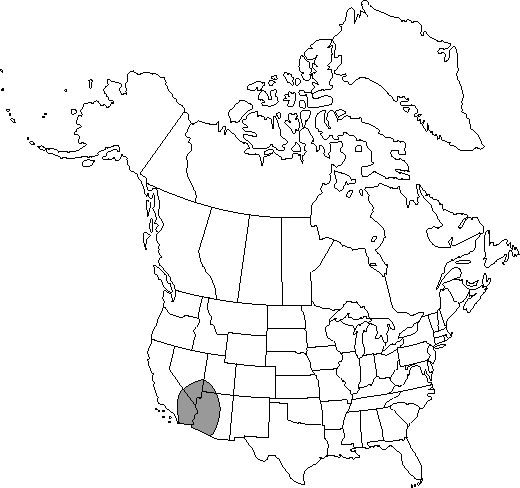Difference between revisions of "Ephedra fasciculata"
Amer. J. Bot. 21: 573. 1934.
FNA>Volume Importer |
FNA>Volume Importer |
||
| Line 23: | Line 23: | ||
}}<!-- | }}<!-- | ||
| − | --><span class="statement" id="st- | + | --><span class="statement" id="st-undefined" data-properties=""><b>Shrubs </b>erect or prostrate, 0.5–1 m. <b>Bark</b> gray, cracked and fissured. <b>Branches</b> opposite or whorled, rigid, angle of divergence about 30°. <b>Twigs</b> pale green, becoming yellow with age, not viscid, usually smooth or very slightly scabrous, with numerous longitudinal grooves; internodes 1–5 cm. <b>Terminal</b> buds conic, 1–3 mm, apex obtuse. <b>Leaves</b> opposite, 1–3 mm, connate to 1/2–3/4 their length; bases membranous, brown, shredding and becoming gray with age, ± persistent; apex obtuse. <b>Pollen</b> cones 2–several at node, ellipsoid to obovoid, 4–8 mm, sessile; bracts opposite, 4–8 pairs, light yellow, obovate, 2–3 × 2 mm, membranous, slightly connate at base; bracteoles exceeding bracts; sporangiophores 3–9 mm, 1/4–3/4 exserted, with 6–10 sessile to short-stalked (less than 1 mm) microsporangia. <b>Seed</b> cones 2–several at node, obovoid to ellipsoid, 6–13 mm, sessile or on short peduncles; bracts opposite, 4–7 pairs, elliptic, 3–7 × 2–4 mm, membranous with light brown to green, thickened center and base, slightly connate at base, margins entire. <b>Seeds</b> 1(–2), ellipsoid, 5–12 × 3–5 mm, light brown, longitudinally furrowed.</span><!-- |
-->{{Treatment/Body | -->{{Treatment/Body | ||
| + | |phenology=Coning March–April. | ||
|habitat=Dry rocky slopes, washes, and sandy areas | |habitat=Dry rocky slopes, washes, and sandy areas | ||
|elevation=300–1200 m | |elevation=300–1200 m | ||
| Line 44: | Line 45: | ||
|basionyms= | |basionyms= | ||
|family=Ephedraceae | |family=Ephedraceae | ||
| + | |phenology=Coning March–April. | ||
|habitat=Dry rocky slopes, washes, and sandy areas | |habitat=Dry rocky slopes, washes, and sandy areas | ||
|elevation=300–1200 m | |elevation=300–1200 m | ||
| Line 51: | Line 53: | ||
|publication year=1934 | |publication year=1934 | ||
|special status= | |special status= | ||
| − | |source xml=https://jpend@bitbucket.org/aafc-mbb/fna- | + | |source xml=https://jpend@bitbucket.org/aafc-mbb/fna-data-curation.git/src/9216fc802291cd3df363fd52122300479582ede7/coarse_grained_fna_xml/V2/V2_388.xml |
|genus=Ephedra | |genus=Ephedra | ||
|species=Ephedra fasciculata | |species=Ephedra fasciculata | ||
| − | |||
| − | |||
| − | |||
| − | |||
| − | |||
| − | |||
| − | |||
| − | |||
| − | |||
| − | |||
| − | |||
| − | |||
| − | |||
| − | |||
| − | |||
| − | |||
| − | |||
| − | |||
| − | |||
| − | |||
| − | |||
| − | |||
| − | |||
| − | |||
| − | |||
| − | |||
| − | |||
| − | |||
| − | |||
| − | |||
| − | |||
| − | |||
| − | |||
| − | |||
| − | |||
| − | |||
| − | |||
| − | |||
| − | |||
| − | |||
| − | |||
| − | |||
| − | |||
| − | |||
| − | |||
| − | |||
| − | |||
| − | |||
| − | |||
| − | |||
| − | |||
| − | |||
| − | |||
| − | |||
| − | |||
| − | |||
}}<!-- | }}<!-- | ||
-->[[Category:Treatment]][[Category:Ephedra]] | -->[[Category:Treatment]][[Category:Ephedra]] | ||
Revision as of 14:18, 27 July 2019
Shrubs erect or prostrate, 0.5–1 m. Bark gray, cracked and fissured. Branches opposite or whorled, rigid, angle of divergence about 30°. Twigs pale green, becoming yellow with age, not viscid, usually smooth or very slightly scabrous, with numerous longitudinal grooves; internodes 1–5 cm. Terminal buds conic, 1–3 mm, apex obtuse. Leaves opposite, 1–3 mm, connate to 1/2–3/4 their length; bases membranous, brown, shredding and becoming gray with age, ± persistent; apex obtuse. Pollen cones 2–several at node, ellipsoid to obovoid, 4–8 mm, sessile; bracts opposite, 4–8 pairs, light yellow, obovate, 2–3 × 2 mm, membranous, slightly connate at base; bracteoles exceeding bracts; sporangiophores 3–9 mm, 1/4–3/4 exserted, with 6–10 sessile to short-stalked (less than 1 mm) microsporangia. Seed cones 2–several at node, obovoid to ellipsoid, 6–13 mm, sessile or on short peduncles; bracts opposite, 4–7 pairs, elliptic, 3–7 × 2–4 mm, membranous with light brown to green, thickened center and base, slightly connate at base, margins entire. Seeds 1(–2), ellipsoid, 5–12 × 3–5 mm, light brown, longitudinally furrowed.
Phenology: Coning March–April.
Habitat: Dry rocky slopes, washes, and sandy areas
Elevation: 300–1200 m
Distribution

Ariz., Calif., Nev., Utah.
Discussion
Selected References
None.